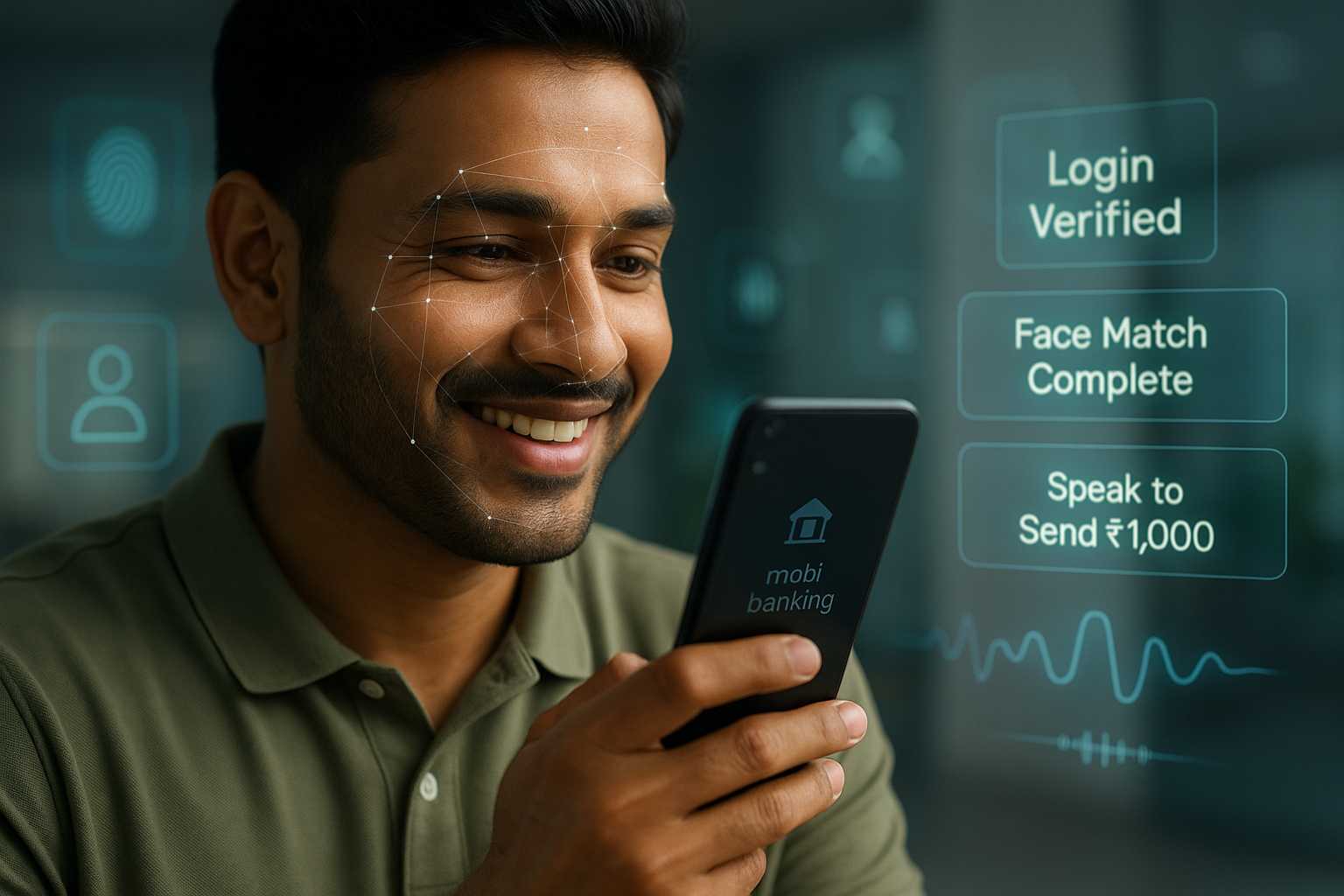As consumers demand greater convenience and security, banks and fintechs are rapidly embracing voice recognition, facial scanning, and biometric authentication to replace traditional PINs and passwords. The emergence of voice-enabled transactions, facial logins, and fingerprint-secured banking is driving a shift toward a passwordless financial future. In 2025, major Indian BFSI players are integrating these biometric technologies into mobile banking, ATMs, and customer verification processes, ushering in a new era of frictionless banking.
Background and Context
India has long been at the forefront of digital identity through Aadhaar-based biometric authentication. With over 1.3 billion Aadhaar enrollments, banks have already linked biometric data with account access and KYC. However, the next evolution involves multimodal biometrics (voice, fingerprint, face) directly embedded into mobile and web banking interfaces.
Post-pandemic digitization, combined with smartphone penetration and AI advancements, has accelerated voice-command banking and gesture-based security protocols. The Digital Personal Data Protection (DPDP) Act, 2023 also mandates stricter consent protocols for biometric use—pushing banks to deploy more secure and transparent systems.
Key Innovations in Voice & Biometric Banking
1. Voice-Based Banking Assistants
Kotak Bank’s Keya and HDFC Bank’s EVA now support:
Balance inquiries
Bill payments
Funds transfers via voice in Hindi, English, and regional languages
Voice biometrics are also used for caller identity verification in contact centers, replacing OTPs.
2. Facial Recognition Login and Verification
ICICI Bank, Paytm Payments Bank, and YES Bank offer face authentication to log in to apps and authorize transactions.
IRIS + Face KYC is used by NBFCs like Muthoot and Lendingkart for instant digital onboarding.
3. Biometric ATMs and Authentication
Aadhaar-enabled Payment Systems (AePS) allow fingerprint-based withdrawals at micro-ATMs.
State Bank of India (SBI) and Canara Bank are testing facial recognition ATMs in pilot cities like Bengaluru and Hyderabad.
4. Behavioral Biometrics
Fintechs like Zighra and OneSpan offer continuous authentication based on:
Typing patterns
Swipe gestures
Device interaction rhythms
“Voice and face are becoming as unique as a password, but infinitely more user-friendly,” says a cybersecurity expert at a leading private bank.
Benefits and Use Cases
Frictionless Access: No need to remember complex passwords or PINs
Enhanced Security: Biometric traits are unique and harder to steal
Financial Inclusion: Voice-based interfaces are enabling access for elderly and semi-literate populations
Faster Onboarding: eKYC using face + Aadhaar reduces TAT from days to minutes
Social Media Reactions and Industry Opinions
@FintechIndiaNow
“Password fatigue is real. Voice & facial login is transforming how India banks. Say goodbye to OTPs! #VoiceBanking #BiometricFuture”
@DigitalIndiaMission
“With multilingual voice banking, India is democratizing digital finance for all—especially rural and senior citizens. #InclusiveBanking”
@CyberSecTodayIN
“Voiceprints are the new fingerprint. Banks must secure biometric data with encryption and comply with DPDP Act. #SecureBiometrics”
Challenges and Regulatory Watch
Privacy & Consent: Under DPDP, banks must clearly explain how voice/face data is used, stored, and protected.
Spoofing Risks: Deepfakes and synthetic voice mimicry pose new threats—requiring liveness detection and multi-factor checks.
Device Limitations: Older smartphones or non-smartphone users may face access barriers.
Data Storage: Biometrics are sensitive personal data—banks must ensure end-to-end encryption and zero-knowledge proof systems.
Future Outlook
Multilingual Voice Banking: Upcoming apps will support over 20 Indian languages for rural and Tier 3–6 banking users.
Liveness Detection and 3D Biometrics: Preventing spoof attacks using depth sensing and micro-expression scanning.
Wearable Biometrics: Smart rings, watches, and earbuds will soon enable gesture- or voice-activated payments.
Cross-App Biometric Wallets: Aadhaar + DPDP-compliant identity wallets will be used for secure one-click authentication across banks and insurance platforms.
Conclusion
India’s transition from PINs to person-based authentication is not just a tech upgrade—it’s a paradigm shift in trust, access, and inclusion. As voice commands replace passwords and facial scans replace OTPs, the future of BFSI lies in secure, seamless, and human-centered technology. For banks, success will depend not only on innovation but also on robust data governance, consent management, and inclusive design.












